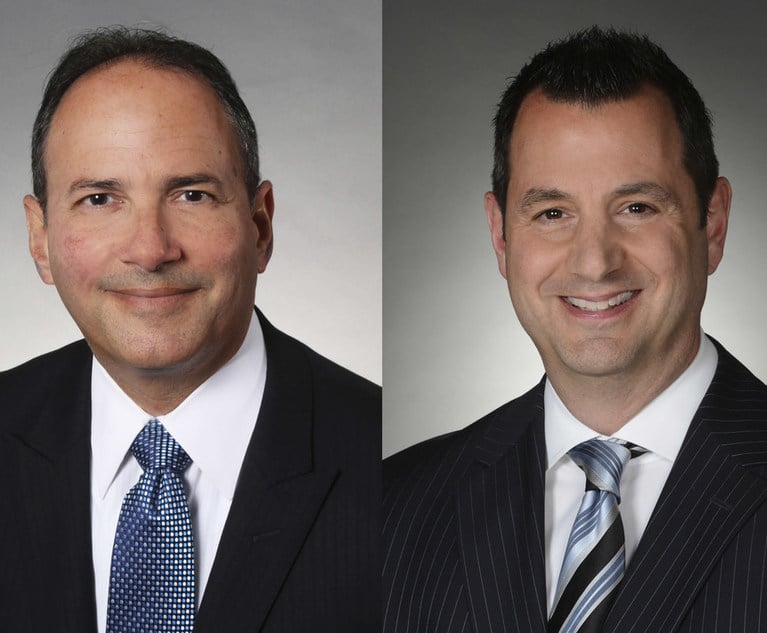Estate: Defendants' Failure to Use Traffic Controls Led to Motorcyclist's Death
On Oct. 4, 2016, plaintiff's decedent William Moon Jr., 55, a shipping supervisor, was motorcycling east on Bredinsburg Road, in Oil City. His motorcycle struck the rear end of a skid-steer loader. Moon fell off of the motorcycle, and he suffered a fatal injury.
July 11, 2019 at 05:00 PM
7 minute read

Moon v. Catalyst Energy
$1,530,000 Settlement
Date of Settlement:
March 12.
Court and Case Number:
Allegheny County Court of Common Pleas, No. GD-16-023830.
Judge:
Michael A. Della Vecchia.
Type of Action:
Motor vehicle.
Injuries:
Back and skull fracture, brain damage, death.
Plaintiffs Counsel:
Alan H. Perer, The Law Firm of Swensen & Perer.
Defense Counsel:
Mark R. Lane, Dell, Moser, Lane & Loughney, Pittsburgh; Michael E. Lang; Margolis Edelstein, Beaver; Alan T. Silko and Robert C. Bechtell Jr., Silko & Associates, Bridgeville.
Plaintiffs Experts:
Todd M. Luckasevic, forensic pathology, Bridgeville; David J. Bizzak, engineering; Homestead; Ronald W. Eck, highway/street; Morgantown, West Virginia.
Defense Experts:
Wayne K. Ross, forensic pathology, Lancaster; Joseph M. Fiocco, traffic, Trevose; Robert T. Lynch, accident reconstruction, Philadelphia; Steven M. Pustay, accident reconstruction, Canonsburg; Steven M. Schorr, accident reconstruction, Abington.
Comment:
On Oct. 4, 2016, plaintiff's decedent William Moon Jr., 55, a shipping supervisor, was motorcycling east on Bredinsburg Road, in Oil City. His motorcycle struck the rear end of a skid-steer loader. Moon fell off of the motorcycle, and he suffered a fatal injury.
Moon's widow, acting as administrator of her husband's estate, sued the skid-steer loader's driver, Michael Brown; Brown's employer, Clint Brown & Sons Inc.; the owner of an adjacent property that Brown was cleaning at the time of the accident, Seneca Resources Corp.; and the company that commissioned the cleaning, Catalyst Energy Inc. The lawsuit alleged that Brown was negligent in his operation of the skid-steer loader. The lawsuit further alleged that the remaining defendants were vicariously liable for Brown's actions.
Plaintiffs' counsel contended that Brown lacked the experience to perform the work he had been asked to perform. He claimed that Brown's sweeping created a large, dark cloud of dust that completely blocked Moon's view of the skid-steer loader. He argued that Catalyst violated safety regulations by sending Brown to operate a large piece of machinery with a road sweeper to clean a buildup of mud on Bredinsburg Road. He contended that statutes and regulations regarding traffic control were violated because the defendants failed to implement flag people, warning signs and flashing lights on the slow-moving skid-steer loader to alert motorists. In a report, the estate's expert engineer opined that the defendants' failure to erect temporary traffic control was the proximate cause of the accident and that, if not for the lack of traffic control, the accident would not have occurred.
In a report, the estate's accident-reconstruction expert calculated Moon's speed at 32 to 35 mph. The expert determined that Catalyst had an obligation to know and implement temporary traffic controls. According to the expert, the company had an obligation to make sure that any contractor it hired to perform roadway maintenance knew of the traffic-control requirements. The expert concluded that Catalyst hired a contractor without ensuring that these safety requirements were known or followed by the contractor it hired.
Counsel of Brown and Clint Brown & Sons Inc. argued that the skid-steer loader was on the public highway for less than 15 minutes, thereby categorizing the work as short duration. He contended that, pursuant to applicable Pennsylvania Department of Transportation publications regarding traffic control, and to the fact that Brown was conducting a street-sweeping event, no traffic-control devices were required.
Brown and Clint Brown & Sons Inc.'s accident-reconstruction experts submitted reports in which they opined that Moon had sufficient time and distance to perceive the skid-steer loader and dust cloud and to react them by gradual brake application, thus avoiding the impact altogether. Regardless of the presence of lights and/or traffic-control devices, the size and density of the skid-steer loader and dust cloud alone was visible for sufficient time and distance to afford Moon the time and distance to slow and stop his motorcycle before reaching the point of impact, according to the experts.
Catalyst maintained that it had committed no wrongdoing. Its accident-reconstruction expert submitted a report in which he opined that the proximate cause of the crash was Moon's failure to slow down in a reduced-visibility environment. The expert contended that the dust cloud over both travel lanes was a clear and obvious restriction to visibility as indicated by an eyewitness, who was an oncoming motorist. According to the expert, the unobstructed line-of-sight distance in the area provided Moon more than twice as much time and distance to observe and react to the local dust cloud surrounding the skid steer as it was sweeping the road surface. The expert concluded that Moon had been driving too fast for the road conditions; 44 mph in a 45-mph zone.
Catalyst's traffic-engineering expert submitted a report in which he opined that the sweeping operation was not required to have advanced-warning traffic controls because it was exempt from requirements of Pennsylvania Department of Transportation publications regarding traffic control.
Moon was airlifted to a hospital and was pronounced dead shortly thereafter. He was diagnosed with significant blunt force trauma to his head, neck and trunk; a laceration of his lower frontal scalp; depressed and comminuted fractures of the frontal bone of his skull, with extension to the orbital bones and anterior base of the skull; lacerations and contusions of the frontal lobes of his brain; fractures of the T2 vertebra and pelvis; and multi-compartmental intracranial hemorrhages of his brain, including subdural, subarachnoid, intra-parenchymal and intraventricular hemorrhages.
Moon was survived by his wife, two children and two grandchildren.
In a report, the estate's expert pathologist opined that Moon experienced at least a few minutes of pain and suffering. The expert based this on the fact that Moon, at the accident scene, acknowledged those who rendered aid to him by attempting to answer their questions, but he could do so only by mouthing words and moving his fingers.
The estate sought to recover damages under wrongful death and survival acts.
The defense's expert pathologist submitted a report in which he opined that Moon suffered no conscious pain and suffering. According to the expert, Moon sustained catastrophic brain injuries that rendered him immediately unresponsive and unconscious, and he remained unconscious for the rest of his life. Due to the catastrophic injuries, the conscious areas of the brain were rendered immediately incapacitated, and Moon was unable to spontaneously respond after the trauma, the expert concluded.
The parties negotiated two pretrial settlements, for a total amount of $1.53 million. Seneca Resources, which was self-insured, agreed to pay $30,000. In a subsequent settlement, mediated by Judge Michael Della Vecchia, Catalyst Energy's insurer agreed to pay $815,000, from a policy that provided a substantially greater amount of coverage, and Clint Brown & Sons Inc.'s insurer agreed to pay $685,000, from a policy that provided a substantially greater amount of coverage.
This report is based on information that was provided by plaintiff's counsel and counsel of Brown, Clint Brown & Sons Inc., and Seneca Resources. Catalyst Energy's counsel did not respond to the reporter's phone calls.
—This report first appeared in VerdictSearch, an ALM publication
This content has been archived. It is available through our partners, LexisNexis® and Bloomberg Law.
To view this content, please continue to their sites.
Not a Lexis Subscriber?
Subscribe Now
Not a Bloomberg Law Subscriber?
Subscribe Now
NOT FOR REPRINT
© 2025 ALM Global, LLC, All Rights Reserved. Request academic re-use from www.copyright.com. All other uses, submit a request to [email protected]. For more information visit Asset & Logo Licensing.
You Might Like
View All
Saul Ewing Loses Two Partners to Fox Rothschild, Marking Four Fla. Partner Exits in Last 13 Months
3 minute read


Feasting, Pledging, and Wagering, Philly Attorneys Prepare for Super Bowl
3 minute readTrending Stories
- 1ACC CLO Survey Waves Warning Flags for Boards
- 2States Accuse Trump of Thwarting Court's Funding Restoration Order
- 3Microsoft Becomes Latest Tech Company to Face Claims of Stealing Marketing Commissions From Influencers
- 4Coral Gables Attorney Busted for Stalking Lawyer
- 5Trump's DOJ Delays Releasing Jan. 6 FBI Agents List Under Consent Order
Who Got The Work
J. Brugh Lower of Gibbons has entered an appearance for industrial equipment supplier Devco Corporation in a pending trademark infringement lawsuit. The suit, accusing the defendant of selling knock-off Graco products, was filed Dec. 18 in New Jersey District Court by Rivkin Radler on behalf of Graco Inc. and Graco Minnesota. The case, assigned to U.S. District Judge Zahid N. Quraishi, is 3:24-cv-11294, Graco Inc. et al v. Devco Corporation.
Who Got The Work
Rebecca Maller-Stein and Kent A. Yalowitz of Arnold & Porter Kaye Scholer have entered their appearances for Hanaco Venture Capital and its executives, Lior Prosor and David Frankel, in a pending securities lawsuit. The action, filed on Dec. 24 in New York Southern District Court by Zell, Aron & Co. on behalf of Goldeneye Advisors, accuses the defendants of negligently and fraudulently managing the plaintiff's $1 million investment. The case, assigned to U.S. District Judge Vernon S. Broderick, is 1:24-cv-09918, Goldeneye Advisors, LLC v. Hanaco Venture Capital, Ltd. et al.
Who Got The Work
Attorneys from A&O Shearman has stepped in as defense counsel for Toronto-Dominion Bank and other defendants in a pending securities class action. The suit, filed Dec. 11 in New York Southern District Court by Bleichmar Fonti & Auld, accuses the defendants of concealing the bank's 'pervasive' deficiencies in regards to its compliance with the Bank Secrecy Act and the quality of its anti-money laundering controls. The case, assigned to U.S. District Judge Arun Subramanian, is 1:24-cv-09445, Gonzalez v. The Toronto-Dominion Bank et al.
Who Got The Work
Crown Castle International, a Pennsylvania company providing shared communications infrastructure, has turned to Luke D. Wolf of Gordon Rees Scully Mansukhani to fend off a pending breach-of-contract lawsuit. The court action, filed Nov. 25 in Michigan Eastern District Court by Hooper Hathaway PC on behalf of The Town Residences LLC, accuses Crown Castle of failing to transfer approximately $30,000 in utility payments from T-Mobile in breach of a roof-top lease and assignment agreement. The case, assigned to U.S. District Judge Susan K. Declercq, is 2:24-cv-13131, The Town Residences LLC v. T-Mobile US, Inc. et al.
Who Got The Work
Wilfred P. Coronato and Daniel M. Schwartz of McCarter & English have stepped in as defense counsel to Electrolux Home Products Inc. in a pending product liability lawsuit. The court action, filed Nov. 26 in New York Eastern District Court by Poulos Lopiccolo PC and Nagel Rice LLP on behalf of David Stern, alleges that the defendant's refrigerators’ drawers and shelving repeatedly break and fall apart within months after purchase. The case, assigned to U.S. District Judge Joan M. Azrack, is 2:24-cv-08204, Stern v. Electrolux Home Products, Inc.
Featured Firms
Law Offices of Gary Martin Hays & Associates, P.C.
(470) 294-1674
Law Offices of Mark E. Salomone
(857) 444-6468
Smith & Hassler
(713) 739-1250





